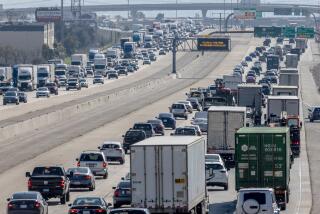Poetry and Smog
- Share via
Poets have labored for centuries to fathom the chemistry of love. The labor to fathom the chemistry of smog is much more an infant art, but the chemists are about as far along on smog as the poets are on love. Not very.
The poets are ahead in two respects. With some exceptions, they have a reasonably good command of the language and they talk of a chemistry with a common denominator of, at the last world census, 6 billion people or so.
Air chemists must discuss their specialty in symbols and computer programs. And it now develops that on one important question they have been laboring under a handicap that would leave a poet speechless--data based on a grand total of two nights of experience.
The question involves one of two ingredients without which there would be no smog--hydrocarbons, basically unburned fuel such as gasoline fumes, and nitrogen dioxide, created by burning fuel, as in an engine.
Some studies a while back--including those two wonderful nights--suggested that smog would be worse if nitrogen dioxides, Nox for short, were too tightly controlled. The theory was that Nox eats Ozone, one element of smog that can be measured easily and therefore is used as the prime indicator of smog levels. Power-plant operators and automobile manufacturers lined up with the studies that said Nox is good for you because it eats Ozone. That made sense. Tighter controls on exhaust pipes or at power plants cost money. In the case of power plants, hundreds of millions of dollars.
But other air chemists argued that even if Nox eats Ozone, it does not do away with the rest of the chemicals in air pollution, any more than somehow covering up beery breath when the Highway Patrol arrived would make a drunk driver’s eyes focus any better. And even if there is less Ozone there still is a lot of nitrogen dioxide in the air, going on to bigger and better things--acid fog and acid rain.
Now a new study by the Air Resources Board in Sacramento raises serious questions about the earlier theories about Nox. It points toward what always has seemed to us nothing more than common sense--less of any ingredient in smog has to be better for people than more.
The Sacramento study will not resolve the argument. But it will force everybody involved in air chemistry back to the computer and the drawing board. And if it turns out that less Nox is what it takes to clean up the air in Southern California, it will force other things as well. It will force the auto companies back to the drawing boards to find a second generation of technology, beyond the catalytic converter, to capture more Nox before it reaches the air. It will force refineries and power plants to invest in a higher level of technology of their own. It will force Southern Californians to decide whether clean air is worth the money. They have been saying yes for decades. They will say it again, once the air chemists settle their argument.






